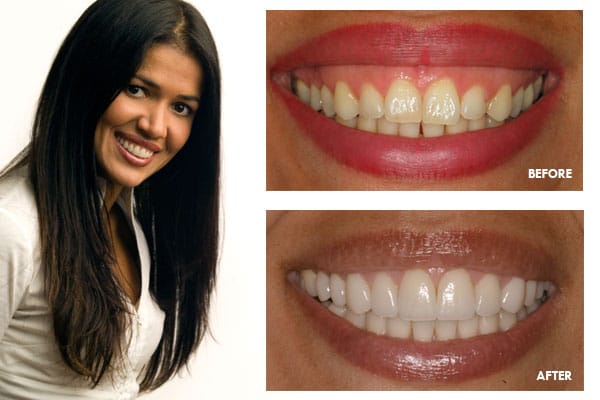Advantages of Porcelain Veneers
- Quickly correct dental wear and restore teeth to what they looked like prior to years of unsightly wear
- Quiclky change the color of teeth to a more desired color
- Quickly Close spaces between teeth to improve smile appearance
- improve lip support to decrease “lines” around the mouth
- conservative because the veneer refaces the front of the tooth and does not require altering the back surfaces of you teeth.
- Veneers do not stain
Are Porcelain Veneers the only way to go, if I want to improve the appearance of my smile?
In many cases, there are other options. Typically, the first solution a cosmetic dentist will turn to are tooth whitening, along with orthodontics and/or reshaping.
In the cases where such methods have not been or will not be effective, porcelain crowns or porcelain veneers are generally the next step for in cosmetic dentistry for patients to explore. Some people will opt to be put to sleep with sedation dentistry for cosmetic dentistry. Dr. Adams offers full IV sedation and laughing gas.
What’s the procedure involved in getting Porcelain Veneers?
You’ll need to visit our office a few times. In an initial consultation, we’ll explain the process in a little more detail and discuss your hopes and expectations for your new smile. Some people want a smile that’s as white as possible, and some prefer a subtler enhancement to their smile.
During a different visit, we’ll remove a small layer—0.5 mm, to be precise—of your tooth’s outer layer. We’ll cover the teeth that are being treated with temporary composite veneers. Permanent veneers are custom made in a lab, and that process takes about a week.
After we put your permanent veneers in, we’ll ask you to come in for a visit again afterwards so that we can check to make sure your bite is still correct. Sometimes, a minor adjustment or two is needed.
Will I still get cavities after getting Veneers?
Patients with veneers still get cavities at the same average rate as other patients.
Will my teeth be more sensitive afterwards?
At the end of the process, no. It is possible that your teeth will be slightly more sensitive for a few days after the temporary veneers are put in.
Can Porcelain Veneers get discolored and stained?
The Veneers themselves cannot be stained.
Is this a permanent fix for my smile?
Veneers are a long-lasting fix. We expect our Porcelain Veneers to last at least 10 years or longer, on the average. Some of our newer ones may last a lifetime. It’s worth noting, however, that the lifespan of a porcelain veneer depends on a person’s habits. veneers will last longer in the mouth of a person who wears a protective mouthguard or night guard while they sleep, or who doesn’t clench in their teeth, for example.
Schedule Consultation


 (301) 421 1996
(301) 421 1996 burtonsvillesmiles@gmail.com
burtonsvillesmiles@gmail.com
